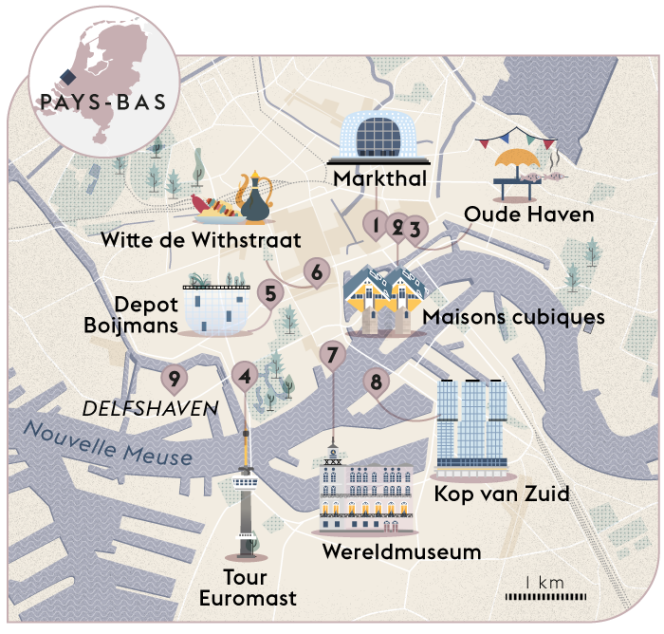On May 14, 1940, despite a counter-order that would never come, the Luftwaffe bombed Rotterdam. In ten minutes, the heart of the city is completely razed. After this tragedy, the city was reborn through audacity: like a snub to history, the greatest architects here gave free rein to their imagination. And dare to dare to disproportionate towers, quirky houses, buildings defying the laws of weightlessness… Vertical lines softened by the omnipresence of water, the city being nestled between the arms of the New Meuse, which flows into the sea of the North. A unique and contrasting landscape, which one quickly learns to love.
Day 1
10 a.m. Hypermarket
To arrive in Rotterdam is to understand at a glance that architects here have no limits. Here we are in front of an impressive gray arch, 40 meters high. Since 2014, just behind Rotterdam-Blaak station, the Markthal (1), designed by the prestigious architecture firm MVRDV, houses a huge food market (a hundred stalls), and 228 apartments on the upper floors. On the ceiling, an 11,000 square meter colorful fresco has giant insects and vegetables twirling around while you get lost between wheels of gouda cheese, Moroccan spices, fluo bubble tea, herring croquettes and rollmops.
11 a.m. Cubic Period
On the other side of the square, as if embedded in the landscape, thirty-eight cubic yellow houses (2), tilted at 45 degrees, hold one knows how upright. It’s Instagram time: color, geometry, optical effect, it’s all there. Designed by deconstructivist architect Piet Blom in the late 1970s, these two-story homes are ultra-functional, with the cubic shape meant to optimize space. You have to enter one of the houses transformed into a small museum to live the experience, or sleep at the Stayokay youth hostel, which has taken over one of the yellow cubes. The others are all inhabited.
12 p.m. On the old port
At the end of the Spaanskade, a pleasant promenade bridge between the cubic houses, here is the water. And the boats. We are on Oude Haven (3)the old port of the city, built in the XIVe century. On the quays, the contrast is striking between this young woman reading on her old rig and the modern skyscrapers in the background. From before the war, only the pretty White House (Witte Huis) remains, which, with its 45 meters in height, was for a long time the tallest building in Europe. We have lunch at the water’s edge, on the sunny terrace of the Stockholm restaurant, with very good grilled fish or barbecue mode integrated into the table.
You have 65.5% of this article left to read. The following is for subscribers only.
